1993 VOLKSWAGEN GOLF oil
[x] Cancel search: oilPage 5 of 156
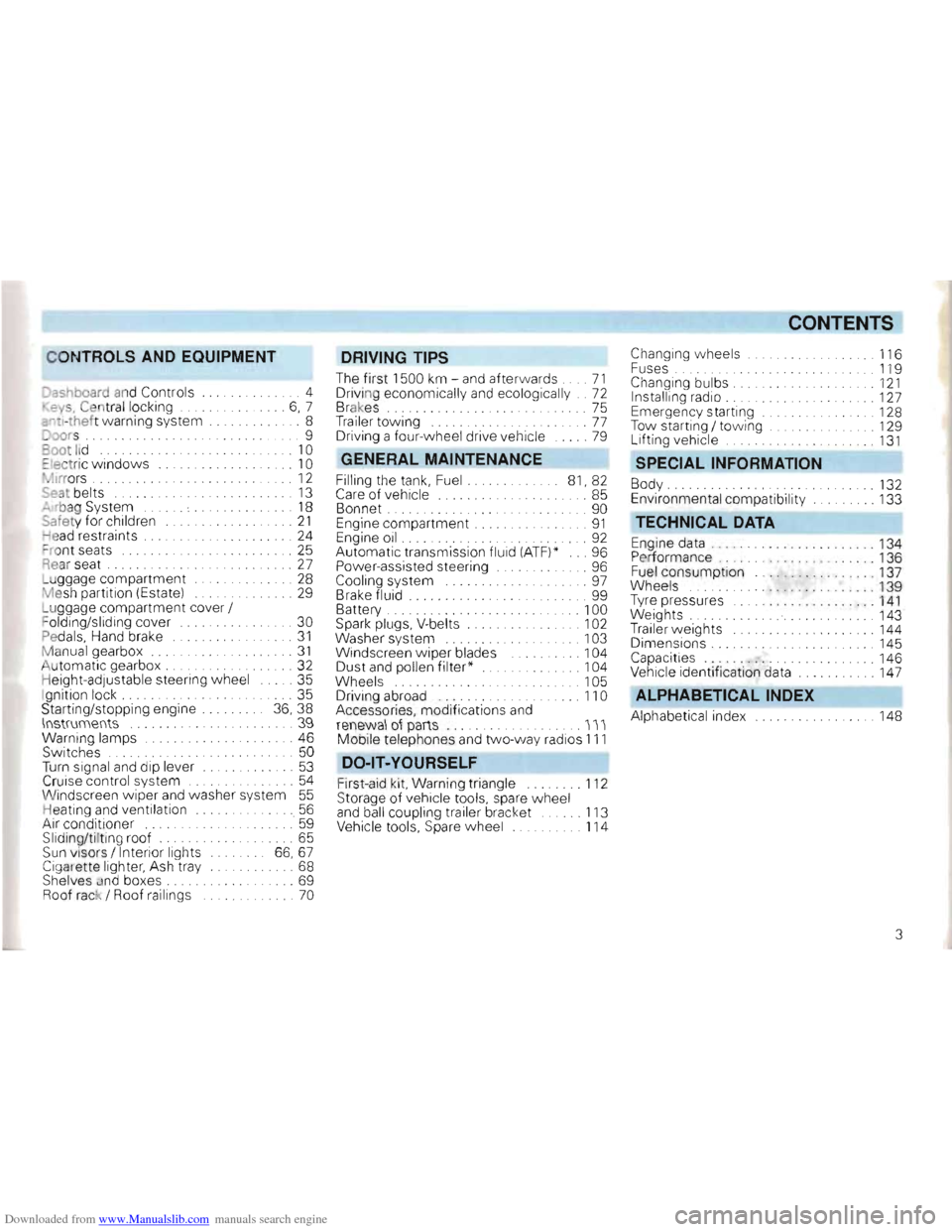
Downloaded from www.Manualslib.com manuals search engine CONTROLS AND EQUIPMENT
Dashboard and Controls ..... 4
. ey s, Cen tral locking . . .... 6, 7
::"tl-thef t warning system .... 8
Joors .......................... .... 9
oot lid .... ........... . . . . . 10
::Iectric windows .. . .. 10
• ~Irrors . . ..... . ... 12
Seal belts 13
"" rbag System . . . . . 18
Safe ty for children .. ... 21
ead restraints . . . . . .. 24
= ro nt seats . . . . . . . . . . . .. 25
Rear seat . . . 27
L u ggage compartment ... . ... . ...... 28
M esh partition (Estate) ...... 29
L u ggage compartment cover /
F olding/sliding cover
... 30
Pedals, Hand brake .. 31
Manual gearbox .... ... .... 31
Automati c gearbox . . . .. .......... 32
H eig ht-adjustable steering wheel ..... 35
I gnition lock. . . . . .. 35
Starting/stopp ing engine 36, 38
\lIstrumellts .. .... 39
Warning lamps ....... 46
Switches . . . . . . . . . . . . . . 50
Turn signal and dip lever ............. 53
Cruise control system ........... 54
Wi ndscreen wipe r and washer system 55
Heating an d ventilation .. . ...... 56
Air cond itioner ......' 59
Sliding/ti ltin g roof. . . . . . . . . . . . ... 65
Sun visors / Interior lights 66,67
Cigarette lighter, Ash tray ..... 68
Shelves and boxes . . . . . . . . . . . ... 69
Roof rack / Roof ra ilings ... 70
DRIVING TIPS
The firs t 1500 km -and after wards .... 71
Driving economically and ecologically .. 72
Brakes. . . . . . . . . . . . . . . . 75
Tra iler tow ing . .. ..... . .... ... ...... 77
Driving a four- wheel drive vehicle .. 79
GENERAL MAINTENANCE
Filling the tan k, Fuel. 81, 82
Care of vehicle ........ .. . . 85
Bonnet . . ... 90
Engine compartment .. ...... .... .... 91
Engine oil ..... .......... ........... 92
Automatic transmission fluid (ATF)* ... 96
Power-assisted steering .. 96
Cooling system . . . . . . . . . . .. . 97
B rake fluid ...... 99
Battery . . . . .. 100
Spark plugs. V-belts . . . . . . . . . 102
Washer system
... . .. 103
Windscreen w iper blades . . . 104
Dust a
nd pollen filter * . 104
Wheel s . 105
D riving abroad ..... ............... 110
Accessories, modifications and
renewa l ot parts .............. III
Mobile telephones and tw o-way rad ios 111
DO -lT-YOURSELF
First -aid kit, Warn ing triangle ........ 112
Storage of vehicle tools, spare wheel
a n d ball coupling trailer bracket ...... 113
Vehicle tools, Spare wheel 114
CONTENTS
Changing w heels . 116
F uses . ........ .. .. . . . ... . .... 119
Changing bulbs. . .... .. . 121
Installing radio . . . . .. 127
E mergency starting .. .. 128
Tow starting / to wing . . .. 129
L ift ing vehicle ......... 131
SPECIAL INFORMATION
Body ..... .... . .......... 132
Environmental compatibility ... 133
TECHNICAL DATA
Engine data . .. , .... .... . 134
P er forman ce .. ... ... ... . .. 136
Fuel consump tion .. 137
Wh eels
. . 139
T yre pressures
.. .. ... .. . . .. ... 1 4 1
Weights ... 143
Trailer weights .. 144
Dimensions. ...... .. ... 145
Capacities " ..... 146
Vehicle identification data ... 147
ALPHABETICAL INDEX
Alph abetical index ... 148
3
Page 42 of 156
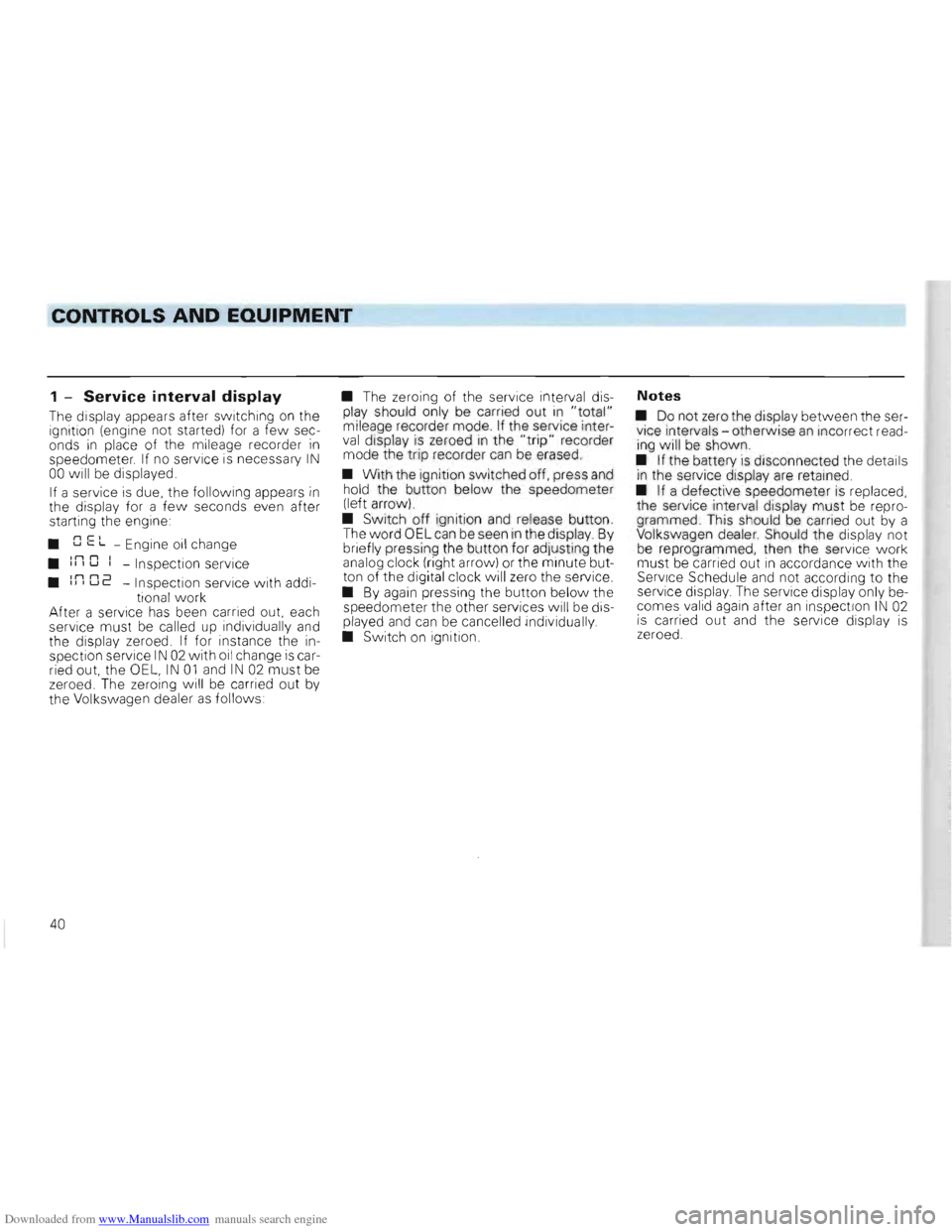
Downloaded from www.Manualslib.com manuals search engine CONTROLS AND EQUIPMENT
1 -Service interval display
The display appears after switching on the
ignition (engine not started) for a few sec
onds in place of the mileage recorder in speedometer. If no service is necessary IN 00 will be displayed.
If a service is due,
the following appears in the display for a few seconds even after
starting the engine
• 0
E: L - Engine oil change
• :n 0 : -Inspection service
• : n 02 -I nspection service with addi
tional work After a service has been carried out, each
service must be called up individually and
the display zeroed . If for instance the in
spection service
IN 02 with oil change is car
ried out, the OEL, IN 01 and IN 02 must be
zeroed . The zeroing will be carried out by
the Volkswagen dealer
as follows : •
The zeroing of the service interval dis
play should only be carried out
in "total" mileage recorder mode. If the service interval display is zeroed in the "trip" recorder
mode the trip recorder can be erased .
•
With the ignition switched off, press and
hold the button below the speedometer
(left arrow)
• Switch
off ignition and release button.
The word OEL can be seen in the display By briefly pressing the button for adjusting the analog clock (right arrow) or the minute but
ton of the digital clock will zero the service.
•
By again pressing the button below the
speedometer the other services will be dis
played and can be cancelled
individually
• Switch on ignition.
Notes
• Do not zero the display between the ser
vice intervals -otherwise an incorrect read
ing will be shown.
• If the battery
is disconnected the details in the service display are retained.
• If a defective speedometer is replaced,
the service interval display
must be repro
grammed This should be carried out by a Volkswagen dealer. Should the display not
be reprogrammed , then the service work must be carried out in accordance with the Service Schedule and not according to the
service display. The service display only be
comes valid again after
an inspect ion IN 02 is carried out and the service display is zeroed.
40
Page 44 of 156
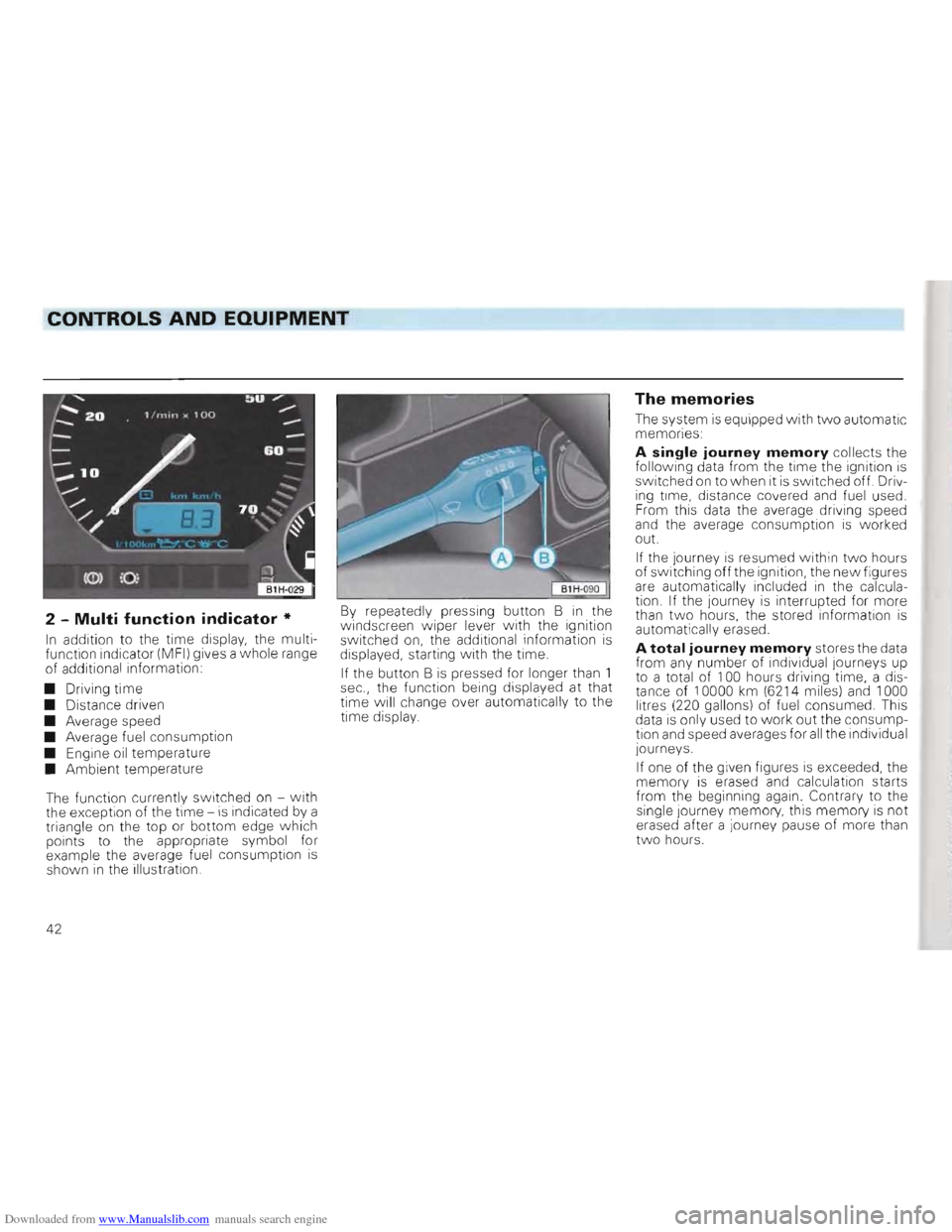
Downloaded from www.Manualslib.com manuals search engine CONTROLS AND EQUIPMENT
2 -Multi function indicator *
In addition to the time display, the multi
function indicator (MFI) gives a whole range
of additional information:
• Driving time
• Distance driven
• Average speed
• Average fuel consumption
• Engine oil temperature
•
Ambient temperature
The function currently switched on -
with the exception of the time -is indicated by a
triangle on the top or bottom edge which
points to the appropriate symbol for
example the average fuel consumption
is shown in the illustration.
By repeatedly pressing button B in the
windscreen wiper lever with the ignition
switched on, the additional information is displayed, starting with the time.
If the button B
is pressed for longer than 1
sec., the function being displayed at that
time will change over automatically to the
time display.
The memories
The system is equipped with two automatic
memories:
A single journey memory collects the
following data from the time the ignition is
switched on to when it is switched off. Driv
ing time, distance covered and fuel used.
From this data the average driving speed
and the average consumption
is worked
out.
If the journey is resumed within two hours
of switching off the ignition, the new figures
are automatically included in the calcula
tion. If the journey is interrupted for more
than two hours, the stored information is
automatically erased.
A total journey memory stores the data
from any number of individual Journeys up
to a total of 100 hours driving time, a dis
tance of 10000 km (6214 miles)
and 1000
litres (220 gallons) of fuel consumed. This
data
is only used to work out the consump
tion and speed averages for all the individual
journeys.
If one of the given figures
is exceeded, the
memory is erased and calculation starts
from the beginning again. Contrary to the
single Journey memory, this
memory is not
erased after a journey pause of more than
two hours.
42
Page 46 of 156
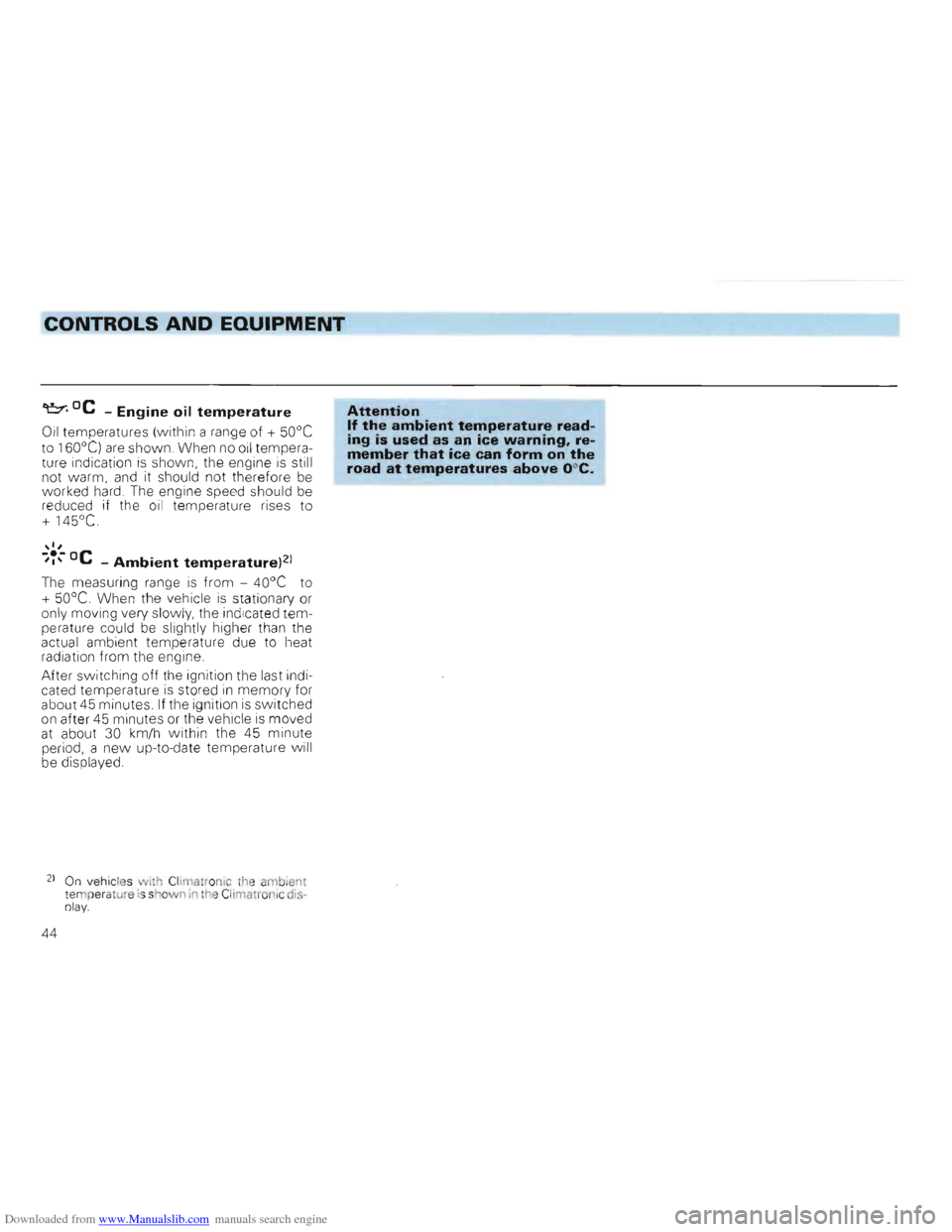
Downloaded from www.Manualslib.com manuals search engine CONTROLS AND EQUIPMENT
~DC _ Engine oil temperature
Oil temperatures (within a range of + 50°C
to 160 °C) are shown. When no oil tempera
ture indication is sho wn, the eng ine is still
not warm, and it should not therefore be worked hard . The engine speed should be reduced if the oil temperature rises to + 145°C.
,I,.e·DC'1' -Ambient temperature)2)
The measuring range is from -40°C to
+ 50°C. When the vehicle is stationary or
only moving very slowly , the ind ic at ed tem
perature could be slightly higher than the
actual ambient temperature due to heat
radiation from the engine.
A fter switching off the ignition the last indi
cated temperature
is sto red in memory for
about 45 minutes . If the ig nition is switched on after 45 minutes or the vehicle is moved at about 30 km/h with in the 45 minute
period, a new up-to-date temperature w ill
be displayed.
Attention
If the ambient temperature read
ing is used as an ice warning, re
member that ice can form on the
road at temperatures above O°C.
2) On vehic le s with Climatr onic 1he amb ient
t empe rature is shown in the C limatr onlc display.
44
Page 48 of 156
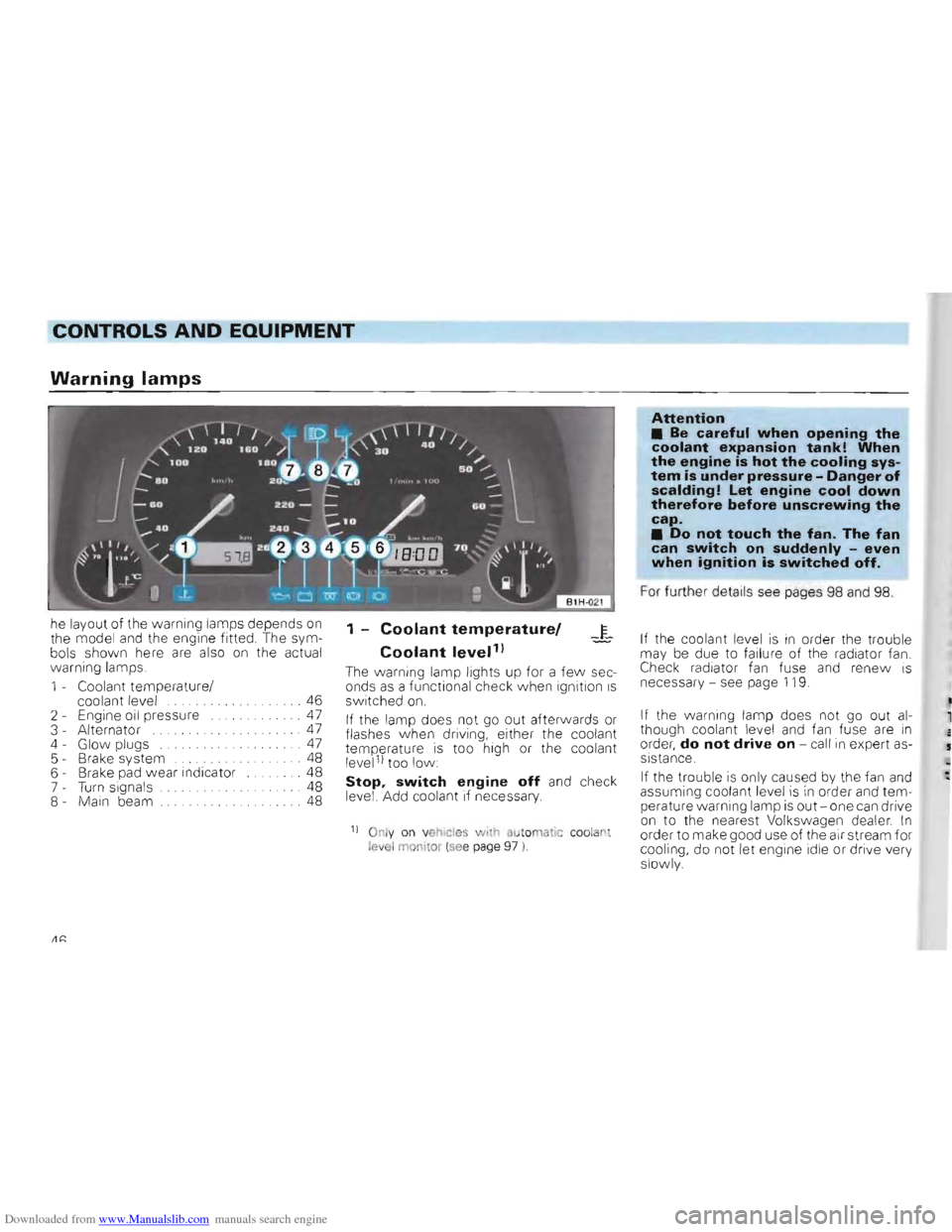
Downloaded from www.Manualslib.com manuals search engine CONTROLS AND EQUIPMENT
Warning lamps
Attention • Be careful when opening the coolant expansion tank! When the engine is hot the cooling system is under pressure -Danger of scalding! Let engine cool down therefore before unscrewing the cap_
• Do not touch the fan. The fan can switch on suddenly -even when ignition is switched off.
For furthe r details see pages 98 and 98.
1 -Coolant temperaturel _~_ If the coolant le vel is in orde r the trouble Coolant level') may be due to failure of the radiato r fan.
Check radiator fan fuse and renew is
T he wa rni ng lamp lights up for a few sec
necessary -see page 119.onds as a functional check when ign ition IS coo lant level .
. 46 switched on.
2 - Engine oil pressure ... .. 47 If the warning lamp does not go out al
If the lamp does not go out afterwards or 3 -Alternator . 47 though coolant level and fan fuse are inflashes when driving, either the coolant 4 -Glow plugs ... 47 orde r, do not drive on -call in expe rt astempe ratur e is too high or the coolant 5 -Brake system .. 48 sistance
.
level1 l too low: 6 -Brake pad wear indicator .48 If the trouble is only caused by the fan andStop, switch engine off and check7 -Turn signals 48
assuming coolant level is in order and temlevel . Add coolant if necessary . 8 -Main beam .
48
perature warning lamp is out -one can drive on to the nearest Volkswagen dealer. In 11 Only 011 vehicl es wi h a t omatic coolant order to make good use of the air stream for level lllonit or (see page 97 l. cooling , do not let engine idle or drive very
slowly .
he
layout
of the warning lamps depends on the model and the engine fitted. The sym
bols shown here are also on the actual
warn ing lamps.
1 -Coolant temperature /
Page 49 of 156

Downloaded from www.Manualslib.com manuals search engine CONTROLS AND EQUIPMENT
2 -Engine oil pressure ~
e wa rning lamp flashes when ignition is :ched on. the lamp must go out when ,=~g ne has started.
, 'Il e warning lamp does not go out or
ash es when driving -a buzzer also sounds
-' e!,gine spe,eds above 2000 rpm -stop, switch engine off, check oil level and if ecessary, add oil -see page 94.
- - he lamp comes
on although the oil level 5 n order, do not drive on. Do not even "'., t he engine at idling speed -call in expert ~slstance.
-du ring the Journe y the engine is operated
a : a speed less than idling speed, it ca n ~ appen that the oil warning lamp lights up. "crease engine speed by accelerating or :'langing down .
Note Th e oil pressure warning lamp is not an oil level indicator. The oil level shou.'d therefore be checked at reg, ular Intervals, preferably every time the fuel tank is filled.J
3 -Alternator
The warning lamp comes on w hen the igni
tion IS sWitched on and must go out when
the engine is started .
The alternator
is driven by a long-life ribbed
belt.
If the warning lamp lights during the
Journey ,
stop, switch off engine and
check ribbed belt.
If
t~e ribbed belt is loose or broken, do not
drive on -the coolant pump is no longer
being driven. The ribbed belt must be
checked/renewed by the next Volkswagen
dealer.
If the ribbed belt
is not loose or broken, one
can normally drive on to the next Vo lks
wag en dea ler. However as the battery is
then discharging co ntinuously , all electrical
consumers which are not absolutely essen
tial should be switched off.
4 -Glow plugs
(Diesel engines only)
When the engine
is cold the w arning lamp
come s on when key IS turned to Drive posi
tion (ignition on)
If the warning lamp does not come on, there IS a defectln the glow plug system -call in expert assistance.
When the lamp goes out, start the engine
Immediately -see page 37.
As the 55 kWDiesel engine glow period be
gins automatically after closing the drivers'
door,
It can happen that after switching to
the driving position (Ignition on) with a cold
engine, that the glow plug warning lamp
does not light up . The engine
can be started
straight away
When the engine
is warm the glow plug
lamp does not come on -the engine ca n be started straight away
Note
If while driving a fault occurs in the engine
management system of the 66 kW Diesel
engine, this
is indicated by a flashing warnIng lamp The engine must be checked by a
Volkswagen dealer as soon as possible.
47
Page 75 of 156
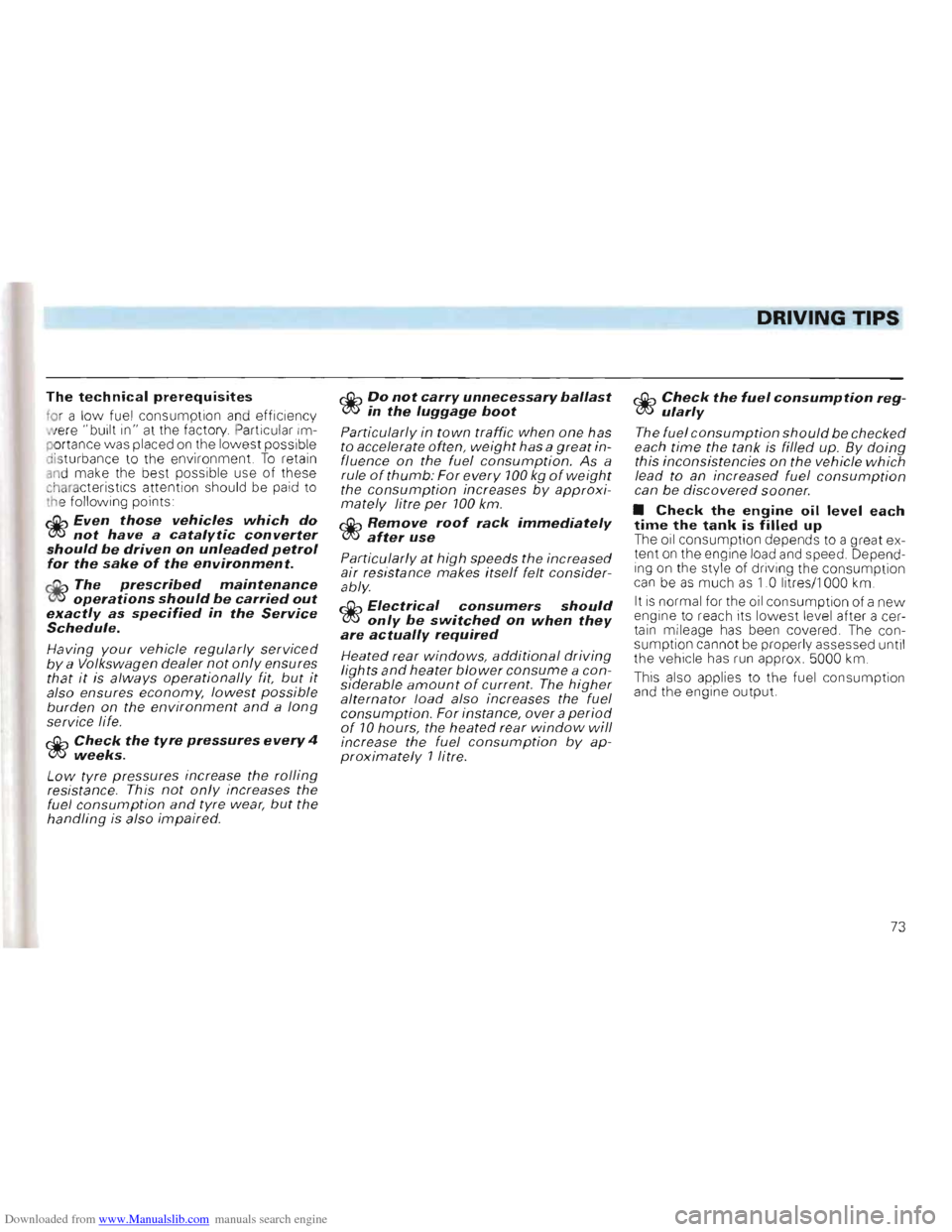
Downloaded from www.Manualslib.com manuals search engine DRIVING TIPS
The technical prerequisites
for a low fuel consumpt ion and efficienc y "" ere " built in" at the factory. Particular Im
p ortance was placed on the lowes t possible
d is turban ce to the enviro nme nt. To retain and make the best possible use of these characteristics attent ion should be paid to the fo llow ing points
~Even those vehicles which do W not have a catalytic converter should be driven on unleaded petrol for the sake of the environment.
~The prescribed maintenance W operations should be carried out exactly as specified in the Service Schedule.
Having your vehicle regularly serviced by a Volkswagen dealer not only ensures that it is always operationally fit, but it also ensures economy, lowest possible burden on the environment and a long service life.
~Check the tyre pressures every 4 W weeks.
Low tyre pressures increase the rolling resistance. This not only increases the fuel consumption and tyre wear, but the handling is also impaired.
~Do not carry unnecessary ballast W in the luggage boot
Particularly in town traffic when one has to accelerate often, weight has a great influence on the fuel consumption. As a
rule ofthumb: For every 100 kg ofweight the consumption increases by approximately litre per 100 km.
~Remove roof rack immediately Wafter use
Particularly at high speeds the increased air resistance makes itself felt considerably.
~Electrical consumers should W only be switched on when they are actually required
Heated rear windows, additional driving lights and heater blower consume a considerable amount of current. The higher alternator load also increases the fuel consumption. For instance, overa period of 10 hours, the heated rear window will increase the fuel consumption by approximately 1 litre.
~Check the fuel consumption regW ularly
The fuel consumption should be checked each time the tank is filled up. By doing this inconsistencies on the vehicle which lead to an increased fuel consumption can be discovered sooner.
• Check the engine oil level each time the tank is filled up The oil consumption depends to a g reat ex
tent on the engine load and speed. Depend
ing on the style of driving the consumption
can be as much as 1 .0 litr es/1 000 km .
It
IS no rmal fo r the oil consumption of a ne w
engine to reach its lowest level after a cer
tain mileage has be en covered . The con
sumption cannot be properly assessed until
the vehicle has run appro x. 5000 km.
This also applies to the fuel consumption
and the engine output.
73
Page 76 of 156

Downloaded from www.Manualslib.com manuals search engine DRIVING TIPS
Trouble-free functioning of the exhaust emission control system is de
c isi ve for the enviro nment-friendly oper
ation of the vehicle .
The follow ing points should therefore
be noted:
• Vehicles fitted with a catal ytic con verter
may onl y be driven on unleaded petrol (see
page 82).
• Never drive until the fuel tank
is com
pletely empty on vehicles with a catal yst.
The irregular fuel supply ca n cause misfir
ing This allows un burnt fuel into the ex
haust system. This can cause overheating
and damage to the catalyst.
• If whilst driving, the engine misfires,
loses power and runs unevenly, this could
be due to a fault in the ignition system . In a
case like this, unburnt fuel can enter the ex
haust system and then escape to atmos
phere. Furthermore, the catalytic converter
could become damaged due to overheat
ing The vehicle speed
must be reduced im
mediately and the defect should be elImIn
ated at the nearest Volkswagen dealer.
• Do not sw itch
off ignition whilst driving
- see page 38 . •
Do not
overfill engine oil-see page 95.
•
Do not tow start vehicle for more than 50 m -see page 130.
Attention Due to high temperatures which can occur in the catalytic converter on petrol engine vehicles in very unfavourable conditions, the vehicle should not be parked so that the catalytic converter can come into contact with inflammable materials_
Note
Even in the case of a perfectl y working ex
haust emission control sy stem there can,
under certain engine operating conditions,
be a sulphur-type exhaust smell.
This depends upon the sulphur content
in
the fuel being used.
Quite often this
can be remedied by select
ing another brand of fuel or, filling up with
unleaded premium petrol.
74